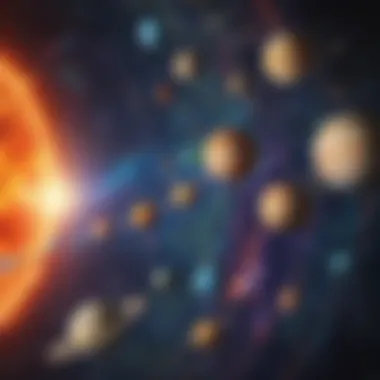Engaging Young Minds: Astronomy for Elementary Students


Intro
Astronomy is an exciting subject that draws curiosity from all age groups, especially from elementary students. The universe holds countless wonders which can inspire young minds. Teaching astronomy to these students provides an opportunity to explore significant concepts like planets, stars, and galaxies. This education lays the foundation for critical thinking and exploration. Children are naturally inquisitive, and harnessing this curiosity can lead to enriching experiences. In this article, we dive into effective methods and rich resources that parents and educators can use to make astronomy engaging.
Science Fun Facts
Young students often find it fascinating to learn small nuggets of fun information about the universe. Here are some interesting trivia and facts:
- Did you know that a day on Venus is longer than a year on Venus? It takes 243 Earth days to rotate once but only 225 Earth days to orbit around the sun.
- Jupiter is the largest planet in our solar system and is so big it could fit 1,300 Earths inside it!
- There are more stars in the universe than there are grains of sand on all the Earth’s beaches. That’s truly mind-boggling, is it not?
- The Milky Way galaxy, the galaxy that contains our solar system, is home to over 100 billion stars. Many are just waiting to be discovered.
Quirky Science Stories
Sometimes real-life stories about scientists can inspire interest in science. Consider the story of Galileo Galilei who challenged beliefs in the 16th century using his telescope. His work laid the foundational concepts for using instruments in studying space.
Amazing Science Records
- The Hubble Space Telescope has captured images of galaxies that are over 13 billion years old. Imagine seeing a glimpse of the past and how big the universe truly is.
- The highest recorded temperature in the universe, near the large Hadron collider, is 5.5 trillion Kelvin. It proves that extremes exist beyond our understanding.
Thought-Provoking Questions
Engaging students in deep questions can stimulate curiosity, such as:
- If you could travel anywhere in the universe, where would you go?
- What do you think happens inside a black hole?
- How do scientists know the age of the universe?
Such questions lead to meaningful discussions that help ground learning in the realities of scientific inquiry. It provides an essential avenue for developing analytical skills and critical thinking among young learners.
Foreword to Astronomy
Exploring the universe and our place within it is a crucial part of education. Astronomy serves as a fundamental pillar, introducing elementary students to various scientific principles. This introduction shapes the way students comprehend nature and fosters curiosity. Through the study of stars, planets, and galaxies, children cultivate problem-solving skills, analytical thinking, and creativity.
Understanding Astronomy
Astronomy encompasses much more than just stars and planets. It involves the scientific study of celestial bodies, the universe, and phenomena that occur beyond Earth’s atmosphere. Children can learn about constellations, the phases of the moon, and remarkable events such as eclipses. Understanding astronomy lays the groundwork for appreciating various branches of science, including physics and geology.
Key aspects of astronomy include:
- The structure of the solar system.
- The life cycle of stars.
- The concept of gravity and its effects.
Engaging students with simple explanations makes complex ideas accessible. Activities such as stargazing or using a simple telescope can go beyond the classroom, sparking interest that lasts a lifetime.
Importance of Astronomy in Education
The relevance of astronomy within the educational landscape cannot be overstated. It plays a significant role in developing scientific literacy. Establishing a solid grasp of astronomical concepts encourages students to observe and question the world around them.
Some benefits of teaching astronomy include:
- Enhancement of Critical Thinking: Astronomy challenges students to ask why things happen the way they do.
- Encouragement of Teamwork: Group projects about planets or solar systems can improve collaboration skills.
- Fostering Imagination: It inspires creativity through the study of unknown territories and rumors of alien life.
Engaging with astronomy can spark a lifelong passion for science across all grade levels. It connects students to broader scientific ideas.
In summary, introducing astronomy opens up rich avenues for inquiry. It promotes exploration and positivity toward scientific learning.
Key Concepts in Astronomy
Understanding key concepts in astronomy is essential for sparking interest in young minds. This section outlines important topics such as the solar system, stars, and galaxies. By focusing on these fundamentals, we help build a strong foundation that can guide students in their exploration of celestial phenomena.
Also, stress on basic principles can lessen misconceptions and nurture curiosity about the universe. Here, we present several components that are beneficial for elementary students and educational instructors alike.
The Solar System
Planets and Their Characteristics
Planets are fascinating bodies found within our solar system. Each planet varies significantly in size, shape, and atmosphere. Let's detail some characteristics of planets:
- Mercury: Smallest and closest to the sun.
- Venus: Known for high temperatures and clouds of acid.
- Earth: The only planet known to support life.
- Mars: Has the largest volcano in the solar system, Olympus Mons.
- Jupiter: Largest planet with a storm called the Great Red Spot.
- Saturn: Famous for its rings, which are composed of ice and rock.
- Uranus: Tilts on its side leading to unique seasons.
- Neptune: Farthest from the sun with strong winds.


Having knowledge about these differences can instill a sense of wonder. This variety touches concepts such as atmosphere, gravity, and distance from the sun—key aspects derived from astronomy.
The Sun's Role
The sun is at the core of our solar system. It provides warmth and light needed for life on Earth.
Key aspects about the sun include:
- Its gravitational force keeps the planets in orbit.
- It fuels photosynthesis through its light.
- Plays a part in climate and weather systems.
The benefits of teaching about the sun includes its role in planetary science. The central point of the solar system makes it easier to understand gravitational pull—a vital concept for students learning about space.
Meteorites and Asteroids
Meteorites are large pieces of natural rock that break off of asteroids. These small rocky bodies orbit the sun, mainly found between Mars and Jupiter.
Meteorites and asteroids provide interesting facts for young learners:
- They can tell us about the early solar system.
- Many contain metals and minerals.
- Some meteorites even reach Earth.
Presenting meteorites allows students to engage with real samples, making learning hands-on. This practical approach fosters a more profound connection with space and its materials.
Stars and Constellations
Types of Stars
Stars come in different kinds, ranging from small red dwarfs to massive blue giants. Understanding different star categories helps grasp the size and brightness of stars. Stars are measured with the following characteristics:
- Temperature: Affects color and light output.
- Mass: Heavier stars tend to live shorter lives.
- Lifespan: Stars can live for millions to billions of years.
For students, learning about types of stars creates foundations for future topics on stellar life processes and the universe.
Understanding Constellations
Constellations have images that humans construct by joining stars in the night sky. This connects the vast expanse of space to human culture and storytelling. Some facts about constellations:
- Various cultures have named the stars differently since ancient times.
- Learning the names can enhance observational skills in young students.
- Many constellations assist in navigation.
Focusing on constellations makes astronomy relatable. It intertwines cultures with science that heightens engagement in astronomy.
Star Life Cycle
Stars go through life stages, such as:
- Nebula: Where stars begin.
- Main Sequence: Stable phase of a star's life.
- Red Giant: The expanding phase before death.
- Black Hole or Neutron Star: Final products.
Understanding the star life cycle illustrates transformation in an accessible way. These concepts help distinguish between ages of stars and grasp galactic life.
Galaxies and the Universe
Types of Galaxies
Galaxies vary by shape and size, largely categorised into:
- Spiral: Like our Milky Way, characterized by curved arms.
- Elliptical: Oval-shaped, made largely of older stars.
- Irregular: Lacks a defined shape usually came from collision.
Exploring these variations serves as a launchpad for future discussions about cosmic evolution, leading to rich questions about the nature of the universe.
Galaxy Formation
Galaxies formed early in the universe, pulled together by gravity. Dark matter also plays a theoretical role in how galaxies Schulble. Discussing this aspect improves communication of current theories and hypotheses. Each formation illustrates how much is still to learn about universal expansion and cosmic history.
Expansion of the Universe
Considered a pivotal observation in modern astronomy, the expansion shows galaxies receding from each other. Its importance arises from cosmological studies. The consequences lead toward concepts regarding the origin of the universe and its ever-changing nature. Understanding expansion triggers deep questions about existence— crucial for developing brighter minds in the field.
Knowledge of these foundations tempts curiosity into realms unknown, pushing exploration towards understanding the cosmos.
Teaching Strategies for Astronomy
Teaching strategies in astronomy play a significant role in shaping how elementary students understand and interact with the universe. Innovative approaches in this topic cater to their natural curiosity while breaking down complex concepts effectively. One crucial element is creating hands-on experiences, as they stir engagement and help children connect theoretical knowledge with visual and tactile learning.


This section outlines various methods to teach astronomy to children, allowing educators and parents to choose what fits their specific needs.
Utilizing Hands-On Experiments
Building a Model Solar System
Building a model solar system stands out as a tactile way for students to explore the components of our solar system. This exercise involves constructing a miniature representation of the planets, their orbits, and the Sun. A key characteristic of this activity is its interactivity, allowing children to physically manipulate and customize their models.
Creating a model enables practical engagement with sizes, distances and figurations of planetary bodies. As a result, this project enhances the students' grasp of concepts such as relative distances and scale. A disadvantage might be the need for materials and space for hands-on building, but with preparation, this is manageable.
The advantage of building a solar system model is fostering collaboration among peers. Kids can work as teams by dividing tasks based on each person's interests. They learn from each other, which establishes a friendly learning environment.
Tracking Stellar Movement
Tracking stellar movement is an excellent avenue for students to understand how the sky transforms with nighttime. By observing and mapping star positions, they become familiar with points of reference. The key characteristic of this activity is real-time analysis; это brings the movements into a uniquely practical perspective.
Students may adopt simple methods like using a notebook and pencil to mark star positions over a few nights or use apps and software to map stars appear. Its interactive nature keeps the lesson engaging. However, a potential drawback is that weather can be unpredictable, which may limit observation nights. Preparing secondary activities for bad weather can ease students’ disappointment.
Moreover, by guiding this investigation, the educator deepens students' comprehension of both cosmic mechanisms and self-directed learning.
Interactive Learning Activities
Planet Research Projects
Planet research projects allow elementary students to study in depth the characteristics of a chosen planet. This strategy engages them in independent study, enabling research on parameters like atmosphere, gravity, and composition, fostering a fascinating exploration of space. A significant characteristic of these projects is that they can be done in formats like presentations, artwork, or reports. This diversity promotes creativity while learning.
The unique feature of this project is its adaptability; students can propose queries aligned with their interests and level of understanding. One downside may be the varying research skills among students, creating disparities in project outcomes. Thus, guidance is necessary for stepping in and assisting students in navigating their investigations efficiently. This promotes peer encouragement and shared knowledge.
Constellation Mapping
Constellation mapping offers students an opportunity to engage with the night sky by recognizing shapes and patterns among stars. This activity yields both a sense of wonder and a sense of achievement when students successfully create their own star maps. Recognizing constellations helps children use the stars as navigational guides and more expansively understand celestial familiarity.
An engaging feature of this activity is drawing a personal constellation chart; this brings art into science, not only improving interest but providing a stimulating approach to learning. Weather and visibility could influence mapping effectiveness negatively; therefore educators must foster a flexible learning schedule around this activity. When well-managed, the rewards from improved spatial awareness and team involvement make it valuable for developing cultural connections with astronomy.
Tech-Enhanced Learning
Astronomy Apps
Astronomy apps play a notable role in making astronomy accessible to kids. These applications provide intutive interfaces to explore celestial bodies and movements conveniently. A significant aspect of these tech tools is how they transform smartphones and tablets into personal planetariums, bringing the cosmos right into the hands of learners. Learning activities improve when children use these tools for tasks like identifying stars and planets in real-time.
One major advantage is the instant feedback aspect. If a child is curious about trying something like spotting Jupiter one evening, an app will help them confidently engage with stars and planets. Keeping young users devoted to learning is essential, with some disadvantages from reliance upon devices for learning. Encouraging offline exploration, paired with these apps, can hit the right balance for a holistic understanding.
Online Simulations
Online simulations act as customizable learning devices, exposing students to various astronomical scenarios like rocket launches or planetary missions. This method escalates lessons beyond textbook confines, providing deeper investigative experiences that stimulate imagination. A key element is that pacms allow tweaking of parameters, these engage students in virtual exploration.
Among the key advantages is the ability to reach fascinating simulations of origins, movements, and life cycles of celestial phenomena that can transcend time and spatial awareness inadequately described by conventional approaches. However, consistent internet access and screen fatigue can pose challenges for young learners. Therefore, it is essential for educators to be mindful in how they integrate this tool effectively into a broader learning curriculum.
Practical and innovative teaching-strategies lay the groundwork for tomorrow's astronomy enthusiasts by helping them grasp scientific concepts and discover their interest in universal phenomena.
Resources for Parents and Educators
Educators and parents play crucial roles in nurturing an interest in astronomy among elementary students. Resources that are selected carefully can enhance learning experiences significantly. With many materials available, choosing those that suit children's learning needs is essential. These resources can address various aspects of astronomy, providing both foundational knowledge and practical skills.
Books and Literature
Books are still one of the best ways to introduce children to a subject as vast as astronomy. They provide a structured pathway to understanding celestial bodies and the laws governing them.
Parents should aim to choose books that captivate the interest of young readers with vivid illustrations and age-appropriate explanations. Titles like There's No Place Like Space by Tish Rabe and the National Geographic Little Kids First Big Book of Space present information succinctly. Such books offer a friendly view into more complex topics while keeping it enjoyable.
Comics and graphic novels also engage the students' imagination. They combine storytelling and facts, which can make learning about the universe fun. Don't forget about interactive books, which often include experiments or questions that challenge young minds. Find ones that spark discussions to deepen understanding and promote a love for exploration.
Websites and Online Platforms
In today's digital age, various websites and online platforms exist that are suitable for elementary school students. NASA’s Kids Club is a great resource. It combines fun games with educational activities that teach kids about space missions, planets, and more. This platform presents activities that are interesting while fostering a more profound understanding of scientific concepts.
Another valuable resource is the Cosmic Kids app, which provides entertaining and interactive content related to astronomy. Websites like britannica.com present comprehensive articles tailored for younger audiences, granting access to vast knowledge. They often include vibrant images that help visualize complex concepts. Parents can engage students in responsible internet use by encouraging safe exploration of these sites.
Astronomy Clubs and Community Events


Local astronomy clubs are excellent resources for extending learning beyond the classroom. They often organize events such as stargazing nights, special talks, and workshops, allowing students to meet with knowledgeable astronomers and peers. Participating in these clubs provides students opportunities to ask questions and share their curiosity in a friendly environment. It helps create fun and genuine connections with others who share their interests.
Community events such as science fairs or planetarium visits are another excellent way to ignite that curiosity. They offer hands-on experiences and immerse learners in the world of astronomy. Also, students may learn about the roles various professionals play in space sciences.
Engaging with multiple resources cultivates a more thorough understanding of astronomy topics. Connections with educators, curated literature, online tools, and community clubs create a rich web of learning experiences. With all these options, parents and educators can spark an ongoing interest in astronomy for young and curious minds.
Challenges in Teaching Astronomy
Teaching astronomy to elementary students presents unique challenges. Understanding these challenges can improve the quality of education and foster a better appreciation for science as a whole. Familiarity with fundamental astronomy concepts is paramount, as misconceptions can distort students' perceptions of the universe. Moreover, educators must effectively address diverse learning styles to ensure each student can grasp these concepts.
Common Misconceptions
Astronomy is a field rich with fascinating ideas and terminology. However, it is not unusual for elementary students to develop misconceptions as they learn. Common misunderstandings include the following:
- Planets and Stars: Children might confuse stars with planets. They may think all bright objects in the night sky represent planets, when most are truly stars.
- Day and Night: Many students may attribute the change between day and night to Earth's movement around other stars, misunderstanding the rotation of Earth itself.
- Seasons: The variation in seasonal changes can be nebulous. Students might not fully grasp how the tilt of the Earth affects temperature and daylight hours throughout the year.
It's crucial to combat these misconceptions early. A clear explanation paired with visual aids helps anchor students' understanding. By reinforcing correct facts through interactive methods, educators can correct misunderstandings before they firmly take root in young minds.
“Teaching students the empirical basis of astronomy can erase deeply held misconceptions about the universe and its workings.”
Addressing Diverse Learning Styles
In any classroom, students have different ways of learning. This is particularly true in a subject like astronomy, where concepts can be abstract. To cater to diverse learning styles, consider the following points:
- Visual Learners: Utilize posters, diagrams, and videos to illustrate solar systems and star formations.
- Auditory Learners: Engage these students through storytelling about famous astronomers or historical events in astronomy. Discussions can reinforce understanding and induce curiosity.
- Kinesthetic Learners: Implement hands-on experiments, like building models of planets or recreating phases of the moon with simple objects. Practical activities tend to enhance comprehension in learners who thrive on physical interaction.
Finding a balance in your teaching approach enhances the overall learning experience. Making accommodations for all learning styles boosts engagement and retention of astronomical knowledge. It is vital to ensure that every student feels included and valued, fostering an environment where exploration and curiosity flourishes.
Future of Astronomy Education
Astronomy education is evolving. Understanding the future of astronomy education is crucial for primary educators and parents promoting a strong scientific foundation. Rapid advancements in technology and a growing emphasis on critical thinking are transforming how students engage with the cosmos.
Integration of New Technologies
New technologies are reshaping astronomy education significantly. Educators can leverage innovations like virtual reality, mobile applications, and interactive simulations. These tools provide immersive experiences for students, making complex concepts more accessible rally exciting.
Benefits of integrating technology include:
- Enhanced Engagement: Students can explore space environments virtually, sparking interest beyond traditional learning methods.
- Interactive Learning: Tools like Stellarium or NASA's Eyes on the Solar System allow students to visually learn about planets, stars, and galaxies in real-time.
- Improves Understanding of Concepts: Interactive apps promote informed inquiry. Science is about asking questions. Digital tools reinvests students' curiosity by enabling space exploration at their own pace.
Encouraging Lifelong Learning
Encouraging a mindset of lifelong learning is fundamental. Instilling a passion for astronomy early on shapes future knowledge-seekers. When students understand the vastness of the universe, they see learning as an infinite journey.
Key strategies for promoting lifelong learning include:
- Curiosity-Driven Activities: Foster natural curiosity with open-ended questions. For example, engage students in challenges like investigating how seasons change on other planets.
- Support from Families: Parents can nurture interests by sharing experiences in astronomy-related events and suggesting books or documentaries. Together, watching a meteor shower builds excitement.
- Resource Awareness: Provide ongoing access to reliable astronomy resources,. Sites like en.wikipedia.org or britannica.com offer a wide range of topics from astrophysics to observational techniques. With communities on reddit.com and actively engaging opportunities, learners can participate and share findings.
Lifelong learning in astronomy guides a unique viewpoint, where each discovery broadens understanding, and deeper exploration fosters critical thinking and innovation.
In summary, embracing new technologies in education and ensuring motivations for continuous discovery allows students to thrive. As we look forward, it becomes clearer that reshaping our educational practices will enhance future learning in astronomy across diverse platforms, ensuring a curious generation ready to explore the stars.
Ending
Summarizing Key Points
In summary, this article has covered essential aspects of astronomy that are crucial for elementary students. Understanding the universe's structure, from the solar system to distant galaxies, lays a foundational knowledge of the cosmos. Children can learn the characteristics of planets and the importance of stars, which encourages their scientific curiosity.
Teaching strategies outlined include hands-on experiments, interactive activities, and utilization of technology. These methods ensure a more engaging approach to learning. Parents and educators play a vital role in facilitating this knowledge through ample resources like books, websites, and educational clubs.
The barriers in teaching, such as misconceptions and diverse learning preferences, have been addressed. It is important to provide tailored strategies that resonate with each child. As technology rapidly evolves, integrating new applications and tools can be beneficial.
The Importance of Continued Exploration
Continuous exploration in astronomy is key for young learners. The universe remains expansive and full of mysteries, making lifelong learning an essential goal. Encouraging students to ask questions fosters an inquisitive mindset that leads to personal drive in scientific pursuits.
Ongoing learning about astronomy ensures that students remain connected with their knowledge. The integration of new discoveries teaches that science is ever-evolving and none of this knowledge is static.
Therefore, instilling a passion for astronomy at a young age can guide children towards career opportunities in various scientific fields. In addition, fostering a sense of wonder promotes emotional and intellectual growth.
"The important thing is not to stop questioning. Curiosity has its own reason for existence." - Albert Einstein
Ultimately, the exploration of the universe will not only enrich students' educational experiences but will also provide them with valuable skills that transcend the classroom.







